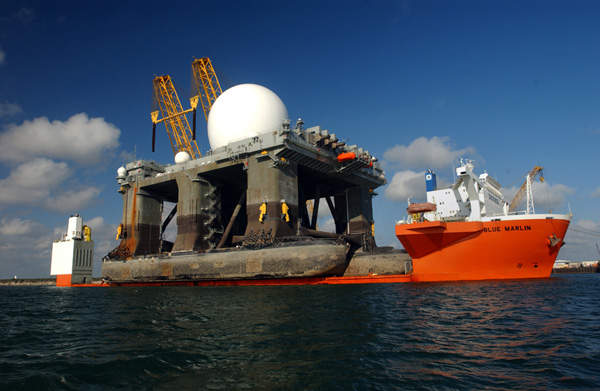The Sea-Based X-Band Radar-1 (SBX-1) constitutes a mid-course fire control radar based on a seagoing semi-submersible vessel. The platform was developed by Boeing, as part of the ground-based midcourse defence (GMD) component of the US Ballistic Missile Defence System (BMDS). The GMD intercepts incoming warheads.
The SBX vessel was transferred to the Military Sealift Command (MSC) in December 2011. MSC operates and maintains the vessel, while the Missile Defence Agency (MDA) is responsible for the x-band radar. The SBX will be assigned with a limited test support role from fiscal year 2013.
On 23 March 2012, SBX-1 sailed from Pearl Harbor to the Pacific region, ahead of North Korea’s planned space launch.
Development history of the SBX-1
In August 2002, Boeing was awarded a $31m contract by MDA to oversee the development of a new sea-based radar system for its BMDS. In January 2003, the US Government purchased a 50,000t semi-submersible seagoing platform from Norwegian company Moss Maritime, for the integration of radar system.
The platform was modified at the Keppel AMFELS shipyard in Brownsville, Texas, to suit the radar outfit requirements, under the supervision of the ground-based midcourse defence joint programme office.
The assembly and installation of the x-band radar on to the platform was completed in April 2005 by Kiewit Offshore Services in Ingleside, Texas. The platform underwent additional alterations at the Pearl Harbor Naval Shipyard in Honolulu, Hawaii.
In July 2005, the vessel was officially named as the Sea-Based X-Band Radar-1 (SBX-1) by the MDA. The SBX-1 underwent a series of sea trials and exercises in the Gulf of Mexico and the Pacific Ocean, prior to its service entry.
Design and features of the Sea-Based X-Band Radar-1 platform
SBX-1 is based on the modified fifth-generation semi-submersible platform of Moss Maritime.
The twin-hulled vessel can withstand high winds and rigid sea conditions. It houses x-band radar, a bridge, control rooms, accommodation units, workspaces, storage spaces, a power generation area and a heli-deck.
The SBX-1 platform is equipped with a command, control and communications system, plus an in-flight interceptor communication system data terminal.
The platform has the capacity to hold supplies and fuel for 60 days. It also offers additional space for installation of new modules.
The vessel has a length of 389ft, beam of 238ft and a draft of 33ft. It can travel at a maximum speed of 9kt. It can accommodate a crew of 87, including officers, civilians, civil service mariners and contract mariners.
SBX-1 missions and US Ballistic Missile Defence System (BMDS) details
The SBX-1, integrated with the BMDS system, provides tracking information of incoming missiles and countermeasures discrimination for GMD interceptor missiles, in order to destroy the threat missile outside the Earth’s atmosphere. It also protects the US and its allied forces from potential missile attacks.
The radar performs cued search, precision tracking, object discrimination and missile kill assessment. The in-flight interceptor communication system data terminal transfers commands from the GMD fire control system to the interceptor missile during its engagement with the target missile.
X-band radar (XBR), built by Raytheon for Boeing
The x-band radar, or XBR, was designed, built and tested by Raytheon for Boeing, the prime contractor of the SBX-1 development. It is the most advanced electro-mechanically steered phased array x-band radar derived from the radar of the Aegis combat system.
The radar beam is formed by the 45,000 transmit / receive modules, mounted on an octagonal flat base. It can see an object similar to the size of a baseball at a range of 2,500 miles. About 69,632 multisectional circuits are used in the radar for transmitting, receiving and amplifying signals.
The 18,000lbs radome measures 103ft in height and 120ft in diameter. It is built with high-tech synthetic fabric material to withstand wind speeds of more than 130mph. Air pressure supports the flexible cover which surrounds the radar.
The vessel is also installed with small rigid radomes. Onboard equipment is powered by six 3.6MW generators.
US Defence Sector – Market Opportunity and Entry Strategy, Analyses and Forecasts to 2015
Detailed analysis and forecasts of the US defence market are available from our business information platform Strategic Defence Intelligence. For more information click here or contact us: EMEA: +44 20 7936 6783; Americas: +1 415 439 4914; Asia Pacific: +61 2 9947 9709 or via email.








